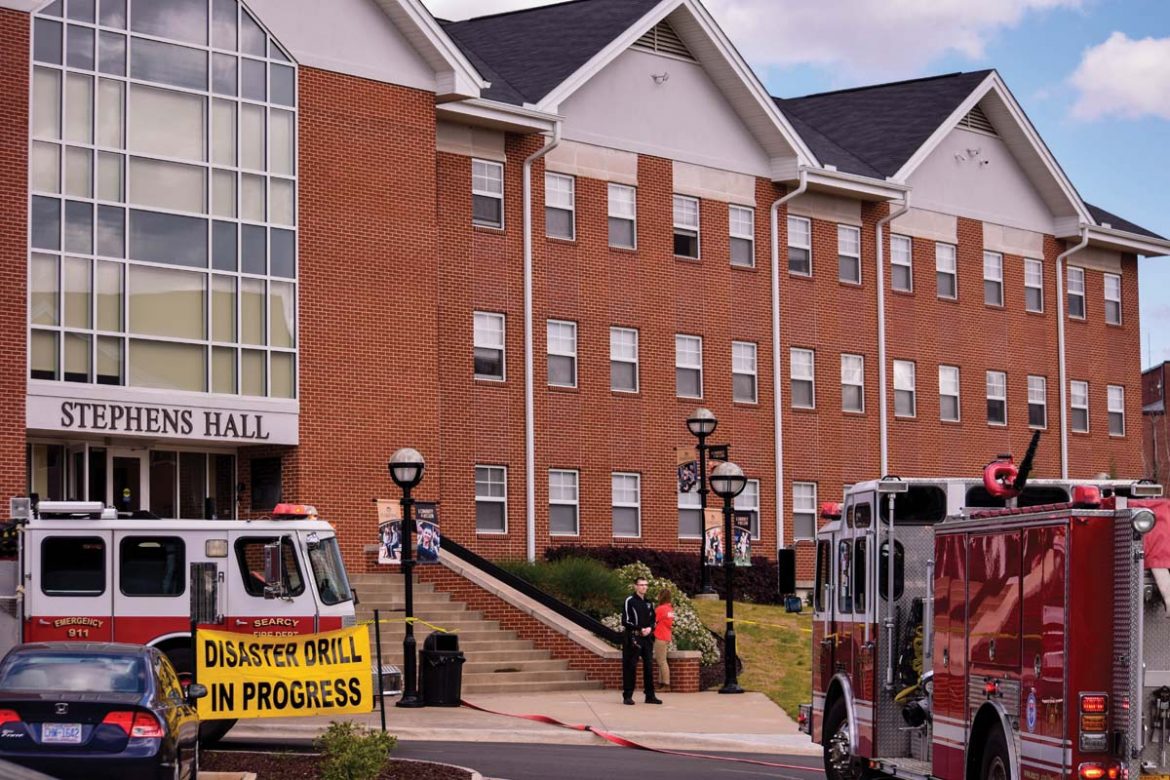Harding’s 15th annual disaster drill was conducted Wednesday, April 6, at women’s residence Stephens Hall. The drill was organized and directed by Public Safety in coordination with a host of students from the College of Allied Health and related fields and members of the Searcy community.
This year, the drill simulated a fire that started in Stephens as a result of too many birthday candles, according to Director of Public Safety Craig Russell.
Russell said that the disaster drill tries to test a new resource each year. This year, that tool was a polling system through the university’s emergency notification system that helps to quickly account for people directly affected by the crisis.
According to Office of Public Relations, the alert system for this year’s drill targeted Stephen’s Hall specifically to determine if residents were in the building or in need of assistance.
“Within 30 minutes of when the drill had started, we had already heard back from one third of the residents in Stephens, and they were accounted for,” Russell said. “(We want to know) who are the known victims and who are the people we know are safe. This particular tool, this technology tool, allows us to (account for people) much, much quicker. We tested that capability this year, and it worked very well.”
According to Russell, the disaster drill has grown each year since its start in 2002, adding more people to the drill as Harding’s programs have expanded, particularly in the field of Allied Health. According to Russell, the drill now has anywhere between 150 and 200 participants each year.
Junior athletic training major Cody Stubblefield said he benefited greatly from this year’s drill. He described his role as a responder as an opportunity to learn how to make decisions in a stressful situation quickly and efficiently.
“I learned just how chaotic those emergency situations are,” Stubblefield said. “You really don’t know what to expect besides the fact there’s going to be injured people. The disaster drill does help in stress management — to just go through the basics, know what to do and how I would respond.”
Stubblefield said that the drill would not be able to happen without the help and coordination of the whole Searcy community. Russell expressed similar sentiments.
“We do not want a real crisis to be the first time that we’ve worked with our local fire department and police department and EMS service,” Russell said. “Because we’ve been doing this for 15 years now, we have regular practice at working with each other, and that has built closer and better relationships that help us make Harding safe and helps us make Searcy a safer community as well.”
Russell said that there are students from nursing school, physicians assistant school, pharmacy school, athletic training, communications and theater who participated in the event. In addition, the Searcy Fire Department, Police Department, County 911 Center, NorthStar EMS and Unity Health joined from the community.
Senior nursing major Chelsie Cloer said that the experience was an interesting one since she was dealing with people that she knew.
“Being something like a dorm on campus made it more real, made it more intense for you to have to think about what you would do in a real scenario,” Cloer said. “Getting to see that perspective and having to work through that in my own brain helped prepare me for my first nursing job in a critical care unit.”
In addition to the physical full-scale drill on campus, several university administrators met at an off-campus site to rehearse tabletop scenarios, according to Russell.
“One of the things we discussed quite a bit (this year) is … how the university will utilize social media in trying to communicate with students in the event of a real crisis,” Russell said. “We try to have some kind of takeaway from every drill that will actually help us improve. This year, it was this new polling system that will help us account for people.”
Russell said that the university’s emergency management plan continues to be tweaked and improved each year based on the success of the drill and cooperation of all members involved in its production.
